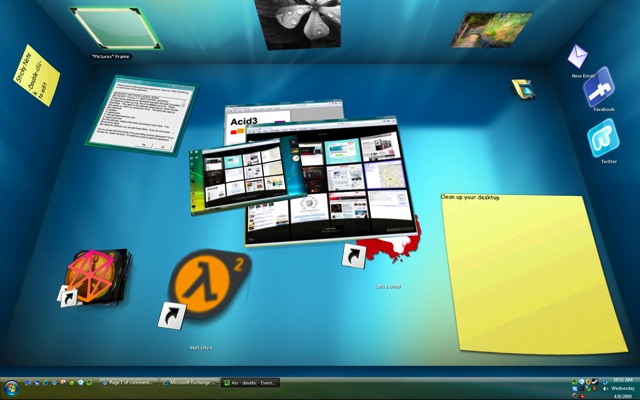
The traditional computing desktop is broken, according to Bump Technologies. Interfaces that force users to drag equally sized icons around a flat canvas and tediously organize them into deliberately named folders haven't improved much across platforms in the past 30 years, which is why the company created BumpTop. Combining the free-form organizational features offered by your real-world desk with the aging desktop paradigm, BumpTop brings an entirely new meaning to "drag and drop."
BumpTop is available in Free and paid Pro versions for Windows XP, Vista, and 7, with Mac OS X and Linux versions in the works. The fundamental idea behind BumpTop is to bring the look, feel, and capabilities of your real world desk (or perhaps more accurately: the five walls of your office) to your computer's desktop.
Instead of dragging ambiguous little icons around on a flat, two-dimensional canvas, files and folders in BumpTop can be scaled up in size, stacked on top of each other, and pinned to 3D walls. Some of the features and effects may seem like needless flair at first, but after exploring BumpTop for a little while, the significant usability shifts that it brings to the desktop become quite intriguing.
Grab a document and flick it to the upper right of the desktop to get it out of your way, and the icon slides up there with a slick animation. Create a sticky note and drag it to the top wall to give it prominence and replace all the stickies around your display. Drag around a set of icons, then right-click or use a keyboard shortcut to stack them into a "pile," just like all those papers on your desk. Double-click the pile later to spread out the pile and find the document you want.

The use of a mouse and keyboard notwithstanding, this is the first aspiring desktop replacement I have seen that actually kind of feels like using a real desk. Animations are smooth, and aside from the occasional collision detection quirks (sometimes a pile knocks around items on a wall when expanded), BumpTop's UI is very interesting.
In addition to organized piles, documents will bump into each other when tossed around, or they can be manually stacked to quickly clean up some clutter. Double-clicking photos on the desktop zooms into them, and you can flip between each photo to stay in that "stance" and get a closer look at everything on your desktop. Double-click a wall and BumpTop shifts its focus, and digital picture frames hung by default can cycle through photos from sites like Flickr and Picasa Web Albums.
If BumpTop has an Achilles' heel, it is that the current version focuses solely on the desktop. Drilling down into folders snaps you out of the BumpTop UI and into a regular Explorer window in Windows, where all of the traditional visual management restrictions still reign. In fact, unless you're on XP or you manually add a My Computer icon to your desktop, there really is no way to get to the rest of your computer with BumpTop.
BumpTop's free version does not include features like tossing files onto USB drives, flipping through piles with a mouse scrollwheel, thumbnail previews of files, frequently used files growing in size automatically, and premium customer support. You can gain all that (and presumably other feature additions in the future) by purchasing BumpTop's $29 Pro version.
Some social tools are also provided in a default BumpTop install. Widgets for Facebook and Twitter are on the right wall, allowing you to drag photos and video for automatically sharing to these networks. They do not serve as clients, however, so you cannot keep in touch with what your friends are up to. But these widgets are a clever way to show off some of BumpTop's interactive abilities, even if they feel a little out of place.
Despite its limitations, BumpTop is a surprisingly successful reinvention of the desktop, with just the right amount of useful visual flair and real-world behavior. Sadly, I don't expect Microsoft or Apple to snap Bump Technologies up before Windows 8 or Mac OS X 10.7 are ready. But it never hurts to start experimenting with new ways to interact and get organized with your computer on your own.
reader comments
58